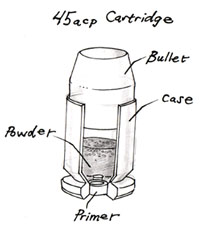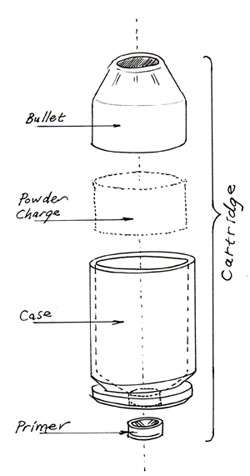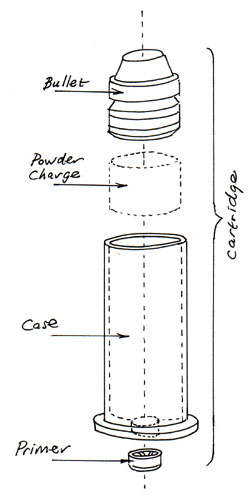Before we get into the process of pistol cartridge reloading, it’s important to make sure we understand the individual components that make up a completed cartridge. Automatic pistol and revolver cartridges are made up of the same basic components, but have some important differences we’ll discuss here.

Cartridge components:
Shell casing
The shell casing (AKA “case”) is the core of the cartridge. If we were talking about a bicycle, this would be the frame. Shell casings contain the powder charge, hold the bullet in place, and house the primer which is used to initiate ignition. Shell casings can be made from a variety of metals, most frequently brass, but you will also find aluminum and steel casings.
Bullet
We all know the purpose of a gun is to send a bullet down range at a high velocity. Bullets have features that are particular to their use, and the type of gun they are used in. Bullets typically are made from lead, and some bullets have a copper jacket that encases a lead core. Some bullets are made entirely of copper.
Powder Charge
The powder contained inside the shell casing is ignited by the primer when the gun fires. The quantity and characteristics of the powder charge will determine the velocity of the bullet, the peak pressure for the cartridge, and effect things like accuracy and range. Selection of a proper powder and proper charge weights are very important considerations for safety and accuracy.
Primer
The primer is a small metal cup with a small quantity of high explosives packed in. The primer is pressed into the base of the shell casing opposite the bullet in a small area called the primer pocket. The primer is struck by the firing pin/hammer of the gun, causing a flame to shoot through the flash hole and ignite the powder charge. Spent primers (with indent from firing pin/hammer) are replaced during the reloading process.
Pistol Cartridge Types:
There are two fundamental types of pistol cartridgets in widespread use today: automatic pistol, and revolver. There are really two main differences, the base of the cartridge, and the means by which the bullet is held in place.
Automatic pistol cartridges:
Automatic pistol cartridges have a recessed groove around their base that is used by the extractor to eject the spent shell casing. The bullet is held in place by neck tension (where the bullet diameter is larger than that of the inside of the shell casing and is pressed into place). Automatic pistol bullets are typically jacketed, but you will some times find copper plated bullets (for lower velocity rounds, plating is much thinner than jacketing) and even lead bullets in some cases.
Diagram: Automatic pistol cartridge overview:

Revolver cartridges:
Revolver cartridges are held in place in the cylinder of the revolver by the rim on the base of the cartridge which is larger in diameter than the body of the shell casing. This prevents the cartridges from falling into the chamber, and is used to eject the shell casings or unfired cartridges from the cylinder. Revolver bullets are held in place by a combination of neck tension (where the bullet diameter is larger than that of the inside of the shell casing and is pressed into place) and a “roll crimp”. Roll crimping involves rolling the opening of the shell casing into a cannelure (for jacketed bullets) or a crimp groove (for lead bullets). By varying the ammount of roll crimp, the peak pressure of the cartridge can be controlled. We’ll get into more detail about bullets in another article.
Diagram: Revolver cartridge overview:

Next: Pistol Reloading Basics
Originally published 01/2009

















































































